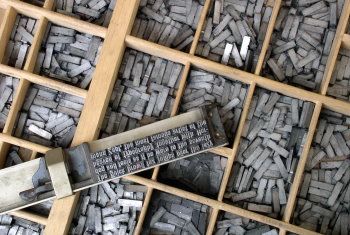Printing Press
Explain how Europe benefited from cultural diffusion during the period c. A.D. 1000 - 1500.
The spread of literacy and the development of universities meant that by the 15th century, there was a growing demand for written language. However, before books could be mass produced, several developments were necessary.
A ready supply of suitable material that could be printed on was required. Early books were written on vellum but it was expensive and not available in sufficient quantity for the mass production of books.
The introduction of the technique of making paper and the subsequent development of a European papermaking industry was a necessary condition for the widespread adoption of print technology.
Although a number of people had previously attempted to make metal type or had experimented with individual woodcut letters, it was not until a technique was devised for producing metal type in large quantities that printing with moveable type became economically feasible.
Johannes Gutenberg (c.1398-1468), who had initially trained as a goldsmith, was to devise a means of producing metal type in sufficient quantities at a reasonable cost. This involved the design of a type-face and the production of molds used for making the individual pieces of type, as well as the development of an alloy that was soft enough to cast yet hard enough to use for printing.

Movable type sorted and loaded in a composing stick.
The mirror image of each letter (rather than entire words or phrases), was carved in relief on a small block. Individual letters, easily movable, were put together to form words; words separated by blank spaces formed lines of type; and lines of type were brought together to make up a page. Since letters could be arranged into any format, an infinite variety of texts could be printed by reusing and resetting the type.
It was also necessary to develop suitable inks for printing with the new type. The water-based inks used for hand lettering and for block printing will not stick to metal type, therefore a viscous oil based ink was required.
Finally, a press was needed for transferring the image from type to paper. Precedents existed in the presses used for making wine, cheese and paper and one of Johannes Gutenberg's innovations was to adapt these presses for the printing process. An operator worked a lever to increase and decrease the pressure of the block against the paper. The invention of the printing press, in turn, set off a social revolution that is still in progress.

Early Printing Press
The immediate effect of the printing press was to multiply the output and cut the costs of books. It thus made information available to a much larger segment of the population who were, of course, eager for information of any variety. Libraries could now store greater quantities of information at much lower cost.
Printing also facilitated the dissemination and preservation of knowledge in standardized form -- this was most important in the advance of science, technology and scholarship.
Printing provided a superior basis for scholarship and prevented the further corruption of texts through hand copying. By giving all scholars the same text to work from, it made progress in critical scholarship and science faster and more reliable
The printing press certainly initiated an information revolution
on par with
the Internet today. Printing could and did spread new ideas quickly and with greater impact.
